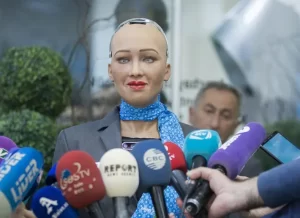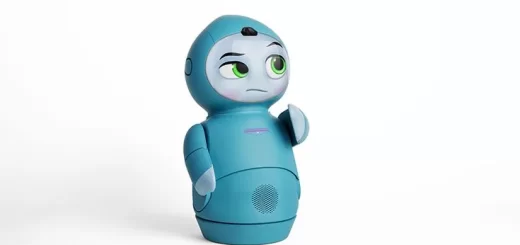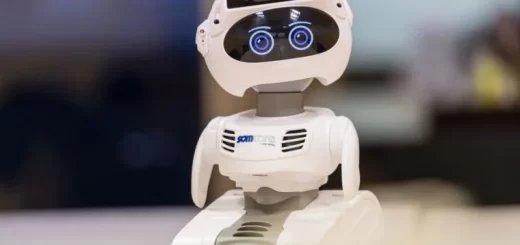Sophia interview, Does robot Sophia have feelings? and Who was the first human-robot?
Sophia robot is known for her social skills and realistic appearance. She can respond to questions and engage in simple conversations on pre-defined topics. She uses speech recognition and pre-programmed responses to simulate natural interaction.
Sophia the Robot
Sophia, the humanoid robot developed by Hanson Robotics, has garnered a lot of attention for her lifelike appearance and ability to interact with people. Sophia represents a significant step in social robotics and AI research. Sophia‘s conversations are based on pre-programmed responses and she doesn’t have true sentience or independent thought.
Sophia functions as an entertainment figure, attending conferences, giving interviews, and participating in panel discussions. Her movements are designed to be fluid and natural, mimicking human gestures during conversation.
Reviewers often praise Sophia’s lifelike appearance and ability to generate human-like facial expressions. This realism sets her apart from many other humanoid robots, especially in social and conversational settings.
While her conversational abilities and AI-driven responses are still developing, Her voice synthesis allows her to respond verbally, though the responses are mostly pre-programmed or guided by her AI modules.
What can Sophia do?
Sophia the robot is known for her social capabilities and realistic appearance. Sophia can hold basic conversations on predefined topics. Sophia‘s design allows her to replicate human facial expressions, making her interactions more engaging.
Sophia can use computer vision to recognize faces and make some basic estimations about a person’s emotions. Sophia can mimic human expressions and respond to questions with scripted responses or pre-programmed information.
She can be used to study social interaction between humans and robots, which could be useful in fields like education and healthcare where robots might interact with people. She can learn and adapt over time, she can improve her conversation skills and responses through interaction.
Sophia uses machine learning to recognize faces, understand some human emotions, and adapt her responses slightly based on the conversation. She can realistically convey emotions through facial expressions, making her interactions more engaging.
Importance of Sophia
Sophia can recognize faces, hold basic conversations, and express emotions through facial expressions. This makes her a potentially valuable tool for education, healthcare (especially for providing companionship to the elderly), customer service, and companionship, especially for those who might benefit from social interaction, where robots can interact with people more naturally.
Sophia can mimic human facial expressions and carry on simple conversations, She is programmed to learn and adapt to new situations through her interactions. This means she could become more sophisticated and helpful over time.
Sophia serves as a platform for advancements in social robotics and artificial intelligence (AI), particularly in areas of human-computer interaction. She could be programmed to tailor interactions to specific individuals, creating a more engaging and personalized experience.
Drawbacks of Sophia
Sophia can’t understand complex concepts or have deep conversations. Her responses are based on pre-programmed information and keywords. Sophia can’t understand nuanced questions. She doesn’t have true artificial general intelligence and can’t think for herself or come up with creative responses.
Despite her human-like features, Sophia‘s conversations are scripted responses triggered by keywords. She lacks true artificial general intelligence (AGI), meaning she can’t understand or respond to questions outside her programming.
As with any automation, there’s a fear that robots like Sophia could replace human jobs in some sectors, particularly those involving repetitive tasks. Sophia‘s media appearances can create an unrealistic perception of AI‘s current capabilities, potentially leading to disappointment or fear.
A robot that appears so human raises questions about sentience and consciousness that she simply doesn’t possess. Additionally, bias in her programming could lead to discriminatory interactions. The development of increasingly human-like robots raises ethical questions about sentience and the potential misuse of AI.
Sophia can’t perform actions in the real world or complete tasks independently. Her ability to learn and adapt is still under development. Sophia primarily functions in a social setting and isn’t designed for physical tasks.
You can follow Science Online on Youtube from this link: Science online
Sophia robot review, features, use, advantages and disadvantages
Top trending topics on Sophia robots and Can Sophia Destroy humans
Educational robotics, Robot teachers, Social robots review, features advantages & drawbacks
Humanoid robots uses, risks, advantages and disadvantages




